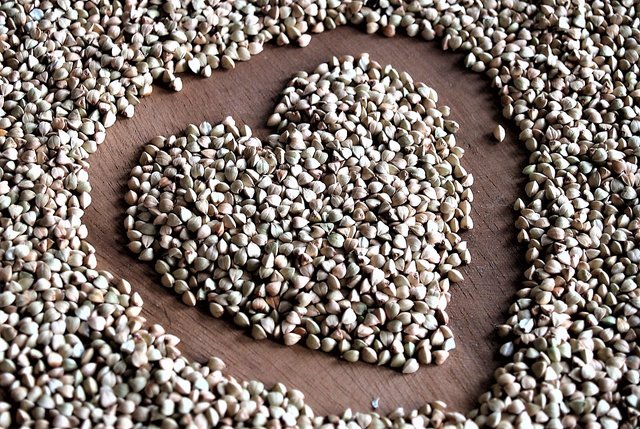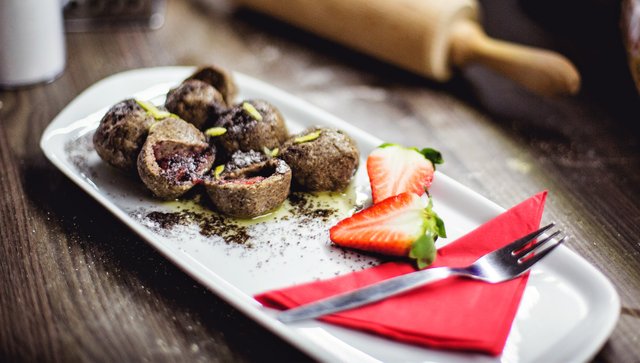A NEW FOOD TREND: BUCKWHEAT (EN / DE)
Everybody is talking about the new power grains: buckwheat. Whether cooked as a side dish, as flour or as muesli flakes - buckwheat is a new nutrition trend that has made the leap from the organic store to the plate of sportive people. And there are good reasons for that!

1. WHAT IS BUCKWHEEAT?
Like amaranth and quinoa, buckwheat grains, which taste slightly nutty, are pseudo grains. Buckwheat is therefore not a cereal but a plant that is more related to rhubarb or sorrel. This makes buckwheat a good gluten-free alternative to wheat, rye, barley or oats. Buckwheat can not only be bought as grains or flour but also as flakes, pops or noodles (soba noodles).
2. EIGHT AMINO ACIDS FOR MUSCLE GROWTH
Buckwheat provides all 8 essential amino acids. These amino acids are called essential because the human body cannot produce them itself, but has to absorb them all through food.
Amino acids are the basic building blocks of proteins that are responsible for repairing or building body tissue (muscle growth). If the body does not have all amino acids at its disposal, it cannot fulfil this task ideally.
Already 3,5 oz buckwheat grains supply the body with 0,35 oz protein!
3. POWER INGREDIENTS
In addition to the essential amino acids, buckwheat also provides the amino acid lysine. Lysine is important for the formation of enzymes and hormones. It strengthens the arterial walls and thus also the cardiovascular system.
In addition, there is the abundant Flavonoid Rutin, which is an antioxidant and can therefore reduce inflammation. It strengthens the walls of the blood vessels and thus prevents the development of varicose veins.
Buckwheat provides B Vitamins such as Riboflavin (Vitamin B2), Niacin (Vitamin B3) and Vitamin B6. But also Folic Acid, Vitamin K and Thiamine. The power grains also supply phosphorus, copper and magnesium.
Buckwheat contains plenty of dietary fibres which promote digestion, bind toxins and promote their excretion via the intestines. 3,5 oz buckwheat grains provide about 20% of the daily dietary fibre requirement.
You haven't tried buckwheat yet? It's really worth trying the powerhouse. Maybe you'll start with buckwheat flakes in your muesli...
XO´s ANNIC

DER NEUE FOOD-TREND: BUCHWEIZEN
Neue Powerkörner sind in aller Munde: Buchweizen. Ob gekocht als Beilage, als Mehl oder als Müsliflakes – Buchweizen ist ein neuer Ernährungstrend, der den Sprung vom Bioladen auf den Teller der Leistungssportler geschafft hat. Und das hat gute Gründe!

1. WAS IST BUCHWEIZEN?
Die leicht nussig schmeckenden Buchweizenkörner zählen wie Amaranth und Quinoa zu den Pseudogetreiden. Buchweizen ist also kein Getreide sondern eine Pflanze, die eher mit Rhabarber oder Sauerampfer verwandt ist. Aufgrund dieser Tatsache ist Buchweizen eine gute glutenfreie Alternative zu Weizen, Roggen, Gerste oder Hafer. Inzwischen kann man Buchweizen nicht nur als Körner oder Mehl sondern auch als Flakes, Pops oder Nudeln (Soba-Nudeln) kaufen.
2. ACHT AMINOSÄUREN FÜR DAS MUSKELWACHSTUM
Buchweizen liefert alle 8 essenziellen Aminosäuren. Diese Aminosäuren werden als essentiell bezeichnet, weil der menschliche Körper sie nicht selbst produzieren kann, sondern alle acht über die Nahrung aufnehmen muss.
Aminosäuren sind die Grundbausteine der Proteine, die für die Reparatur bzw. den Aufbau von Körpergewebe (Muskelwachstum) zuständig sind. Hat der Körper nicht alle Aminosäuren zur Verfügung, kann er diese Aufgabe nicht ideal erfüllen.
Integrieren wir Buchweizen in unsere Ernährung, geben wir unserem Körper alle Aminosäuren und somit mit alle Bausteine die er braucht um erforderliche Aufbauarbeiten durchführen zu können. Bereits 100g Buchweizenkörner liefern dem Körper 10g Protein!
3. POWERSTOFFE IN HÜLLE UND FÜLLE
Neben den essenziellen Aminosäuren liefert Buchweizen auch die Amino- säure Lysin. Lysin ist für die Bildung von Enzymen und Hormonen wichtig. Es stärkt die Arterienwände und somit auch das Herz-Kreislauf-System.
Hinzu kommt das reichlich vorhandene Flavonoid Rutin, das antioxidativ ist und somit Entzündungen reduzieren kann. Es stärkt die Wände der Blutgefäße und beugt dadurch die Entstehung von Krampfadern vor.
Buchweizen liefert B Vitamine wie Riboflavin (Vitamin B2), Niacin (Vitamin B3) und Vitamin B6. Aber auch Folsäure, Vitamin K und Thiamin. Die Powerkörner liefern zudem Phosphor, Kupfer und Magnesium.
Buchweizen enthält reichlich Ballaststoffe, die die Verdauung fördern, Toxine binden und deren Ausscheidung über den Darm fördern. 100g Buchweizenkörner liefern circa 20% des täglichen Bedarfs an Ballast- stoffen.
Ihr habt Buchweizen noch nicht ausprobiert? Es lohnt sich wirklich das Powerkorn zu probieren. Vielleicht beginnt Ihr mit Buchweizenflakes im Müsli...
XO´s ANNIC

Hallo Annic, das klingt sehr gut, muß ich mal testen. Liebe Grüße Alexa
Hallo Alexa, Buchweizen ist auf jeden Fall einen Versuch wert, da es irre gesund ist. Es wurde früher in Deutschland viel gegessen, ist dann aber aus der Mode gekommen. Auf Steemit postest Du ja zur Zeit Rezepte - vielleicht findest Du ein besonders gutes Rezept mit Buchweizen und teilst es irgendwaqnn mit uns. Bei mir kommen Buchweizenflakes fast immer in mein Müsli. Liebe Grüße, ANNIC
Nice - would love to try it :)
Yes, buckwheat is worth a try. Good food helps to work focused.
Congratulations @annic! You have completed the following achievement on the Steem blockchain and have been rewarded with new badge(s) :
Click here to view your Board of Honor
If you no longer want to receive notifications, reply to this comment with the word
STOPDo not miss the last post from @steemitboard: